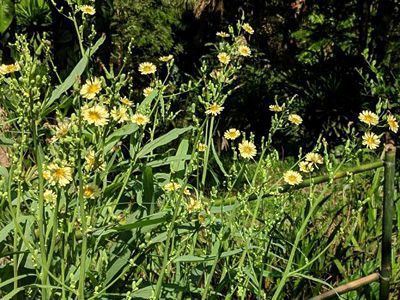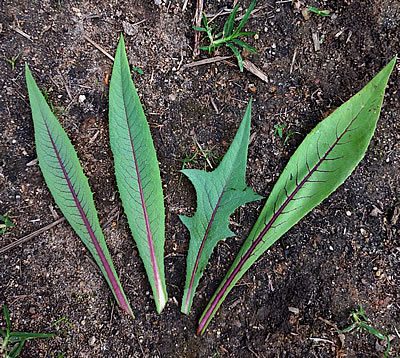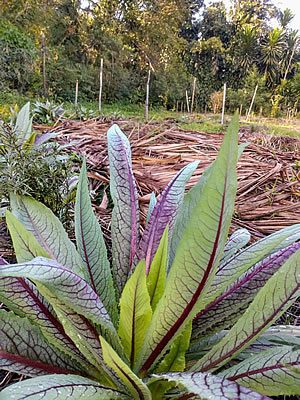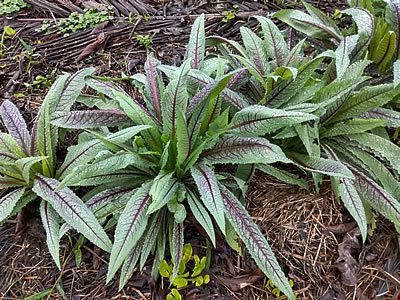
Canada lettuce (Lactuca canadensis) is an annual herbaceous plant, upright, vigorous, milky-sapped, with branched and foliated stems. It can easily reach up to six and a half feet in height when grown in full sun. Its nearly silver leaves with purplish veins are pointed. The pale yellow flowers are arranged in broad terminal panicles, resembling the flowers of lettuce and dandelion (in a more discreet coloration).
When the flowers close, they quickly produce “pompom” clusters filled with black seeds (achenes with pappi) – which will spread all around carried by the wind. Due to this ease of propagation, the plant can also be considered invasive in certain situations. It rapidly spreads in gardens, pots, sidewalk crevices, corners, vegetable gardens, orchards, and so on.
It’s an annual plant, and as such, it grows, blooms, seeds, and completes its cycle within a year. It’s a vegetable that requires minimal care, even in times of drought. Its propagation is solely through seeds. To plant the seeds, simply cover them with a thin layer of soil directly in the bed or pot and keep the soil moist until germination is complete. No mystery involved.

A relative of lettuce, endive, and other types of lettuce, this plant is extensively cultivated in home gardens throughout the country. In the South and Southeast, it’s considered semi-spontaneous. It mainly appears in the cooler seasons, autumn and winter. As soon as the cold weather arrives, wild Canada lettuces begin to emerge in the yard, bringing color and beauty to the garden.
There are different varieties: smooth leaves, serrated leaves, and leaves without purplish veins – all of them appearing spontaneously. Don’t hesitate to eat the leaves of your Canada lettuce. Start by harvesting the lower leaves, and the plant will grow like a kale plant. You can have multiple harvests from the same Canada lettuce plant.
When I say that Canada lettuce grows in the wild, few believe it because of how beautiful it is. Not only is it beautiful, but it’s also ornamental, spontaneous, medicinal, and edible.
Highly flavorful and versatile in the kitchen, its leaves can be consumed raw or cooked. Despite this, it’s still unfamiliar to most people, making it an unconventional edible plant. Fortunately, in some regions of Brazil, this tasty green is already available in agroecological markets.
Personally, I prefer to eat them raw in salads and vinaigrettes. But I also use them in stuffing, green soups, regular soups, and sautés. Even though this leafy vegetable is slightly bitter, some can’t tolerate any bitterness in their food. In such cases, just slice the leaves and soak them in water for a few minutes to remove the sap. However, by doing this, you’ll lose some of the plant’s medicinal properties, which are known in traditional medicine to protect the liver and aid digestion. It combats liver, spleen, gallbladder, and kidney disorders. As the saying goes: all bitter greens protect the liver.

The young floral stems are also edible. In fact, the entire plant is edible. The root, before flowering, can be harvested, chopped with a sharp knife, sun-dried, and used to make tea. Its roots have a strong history in Europe. After being dried and roasted, they once served as a coffee substitute in the olden days. And today, this type of preparation has become a delicacy. I imagine conventional vegetable producers in Brazil with a “Canada lettuce infestation” on their property. Harvest everything, roast the roots, and launch a “gourmet coffee” made from Lactuca canadensis. I’d buy it to try.
But…don’t go yanking the plant out by its roots to roast everything. Unless you have a Canada lettuce infestation in your garden, leave the plant be, let it bloom, seed, and fulfill its mission to spread its descendants across the world. And if after seeding, you end up with many seedlings, you can donate them to friends, neighbors, community gardens, or urban gardening groups. Canada lettuce in the garden signals fresh, pesticide-free, medicinal, nutritious, and free greens. Think about it.


